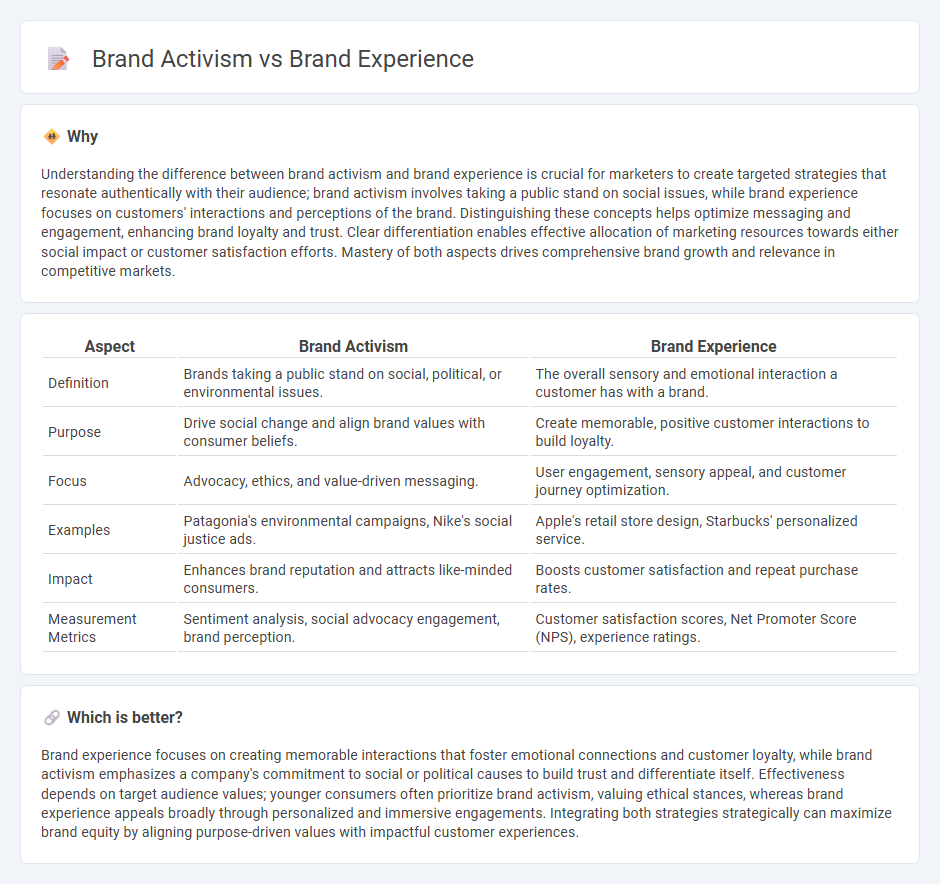
Brand activism refers to a company's efforts to promote social, environmental, or political causes as part of its core identity, influencing consumer perception and loyalty. Brand experience focuses on creating immersive, memorable interactions that engage customers emotionally and sensorially to build long-term relationships. Explore the distinct strategies behind brand activism and brand experience to enhance your marketing impact.
Why it is important
Understanding the difference between brand activism and brand experience is crucial for marketers to create targeted strategies that resonate authentically with their audience; brand activism involves taking a public stand on social issues, while brand experience focuses on customers' interactions and perceptions of the brand. Distinguishing these concepts helps optimize messaging and engagement, enhancing brand loyalty and trust. Clear differentiation enables effective allocation of marketing resources towards either social impact or customer satisfaction efforts. Mastery of both aspects drives comprehensive brand growth and relevance in competitive markets.
Comparison Table
| Aspect | Brand Activism | Brand Experience |
|---|---|---|
| Definition | Brands taking a public stand on social, political, or environmental issues. | The overall sensory and emotional interaction a customer has with a brand. |
| Purpose | Drive social change and align brand values with consumer beliefs. | Create memorable, positive customer interactions to build loyalty. |
| Focus | Advocacy, ethics, and value-driven messaging. | User engagement, sensory appeal, and customer journey optimization. |
| Examples | Patagonia's environmental campaigns, Nike's social justice ads. | Apple's retail store design, Starbucks' personalized service. |
| Impact | Enhances brand reputation and attracts like-minded consumers. | Boosts customer satisfaction and repeat purchase rates. |
| Measurement Metrics | Sentiment analysis, social advocacy engagement, brand perception. | Customer satisfaction scores, Net Promoter Score (NPS), experience ratings. |
Which is better?
Brand experience focuses on creating memorable interactions that foster emotional connections and customer loyalty, while brand activism emphasizes a company's commitment to social or political causes to build trust and differentiate itself. Effectiveness depends on target audience values; younger consumers often prioritize brand activism, valuing ethical stances, whereas brand experience appeals broadly through personalized and immersive engagements. Integrating both strategies strategically can maximize brand equity by aligning purpose-driven values with impactful customer experiences.
Connection
Brand activism and brand experience are interconnected as both focus on engaging consumers through meaningful interactions that align with their values and social concerns. Companies that actively demonstrate commitment to social, environmental, or political causes enhance brand experience by creating emotional connections and trust with their audience. This synergy boosts customer loyalty, brand differentiation, and long-term business growth.
Key Terms
Brand Experience:
Brand experience encompasses the sensory, emotional, cognitive, and behavioral responses a consumer has with a brand through various touchpoints like advertising, product use, and customer service. It aims to create memorable interactions that build brand loyalty and drive customer engagement. Explore how crafting a compelling brand experience can transform your customer relationships.
Customer Engagement
Brand experience centers on creating immersive interactions that foster emotional connections and loyalty, enhancing customer engagement through sensory and personalized touchpoints. Brand activism involves taking a public stance on social, environmental, or political issues, encouraging customers to engage based on shared values and social responsibility. Explore how integrating both approaches can deepen customer engagement and drive meaningful brand-consumer relationships.
Sensory Interaction
Sensory interaction in brand experience engages consumers through sight, sound, touch, taste, and smell to create memorable and immersive brand perceptions. In contrast, brand activism leverages sensory elements to convey social or environmental commitments, fostering emotional connections that align with consumer values. Explore how integrating sensory strategies enhances both brand engagement and purposeful activations.
Source and External Links
Everything You Need to Know About Brand Experience - Brand experience is the lasting impression customers have of your brand, covering their thoughts, feelings, perceptions, and reactions to every interaction, forming an emotional connection beyond just product use.
How to create an unforgettable brand experience design - Brand experience design is a strategic approach that combines creativity, usability, and emotional connections across all customer touchpoints to build a cohesive, memorable relationship that fosters loyalty and business growth.
What is Brand Experience and Why is it Important? | Amazon Ads - Brand experience refers to the overall perception customers develop from all interactions with a business, including advertising, digital marketing, product quality, and customer service, which collectively shape the customer's holistic view of the brand.
 dowidth.com
dowidth.com